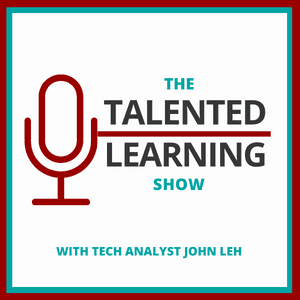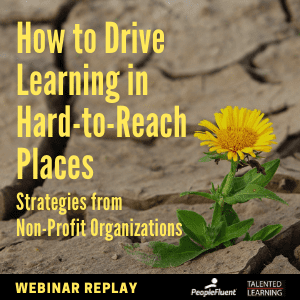
Podcast: Play in new window | Download
Subscribe: Apple Podcasts | Spotify | Amazon Music | Android | iHeartRadio | Blubrry | Email | RSS
WELCOME TO EPISODE 8 OF THE TALENTED LEARNING SHOW!
To learn more about this podcast series or to see the full collection of episodes visit The Talented Learning Show main page.
EPISODE 8 – TOPIC SUMMARY AND GUEST:
The first version of xAPI was released 5 years ago. Yet many learning professionals still aren’t sure what it is or how it works. What is the relationship between xAPI and learning measurement? Does it work with any LMS? And what kind of real-world business benefits come from using xAPI data?
 Today I explore these questions with one of the world’s leading experts in learning analytics, Mike Rustici. A software-developer-turned-entrepreneur, Mike has been shaping the direction of the elearning industry for nearly 20 years.
Today I explore these questions with one of the world’s leading experts in learning analytics, Mike Rustici. A software-developer-turned-entrepreneur, Mike has been shaping the direction of the elearning industry for nearly 20 years.
He’s best known as the founder of Rustici Software, where he advanced SCORM market adoption and developed its next-generation standard, the xAPI. These days, Mike serves as the founder and CEO of Watershed and continues as a learning standards and analytics thought leader.
KEY TAKEAWAYS:
- For extended enterprise professionals, measuring the business impact of learning programs is essential. The xAPI data standard adds value to this process by making it possible to link all types of learning activities with business performance metrics.
- While early adoption has focused on employee training, xAPI is able to drive learning analytics for customer education and other extended enterprise programs.
- Starting small is a legitimate way to discover how xAPI can help you improve learning programs and related business results.
Q&A HIGHLIGHTS:
Typically, extended enterprise learning professionals aren’t part of the HR function, so they’re confused by elearning jargon. SCORM and xAPI are perfect examples. How are these terms related, and why do they matter?
First, let’s clarify the meaning of SCORM. This is a data standard created in 2000 by the Department of Defense to govern how an elearning course plays through an LMS to a known learner who is using a connected web browser.
Elearning and LMSs were really taking off at the time and SCORM became the glue that held them together. It was brilliant for its time. But it’s just one small example of the way we learn.
When did xAPI enter the picture?
By 2012, they realized they needed to refresh the way learning systems interact with one another. That’s when they gave my company, Rustici Software, a research grant to collect requirements and propose a next-generation learning interoperability standard.
We called it the Tin Can API, which is now known as xAPI or Experience API. These are different names for the same thing.
So in a nutshell, this interoperability makes it possible to create content once and it will work on any platform that supports the standard?
Exactly. Both SCORM and xAPI are standards that ensure learning content and systems work together.
Will xAPI replace SCORM?
Some people say xAPI is the successor to SCORM – and in a sense that’s true because it will replace SCORM. But that’s an over-simplification because xAPI does so much more than SCORM. The big difference is that xAPI allows us to track information about all learning activities that happen, not just the tiny fraction delivered through an elearning course in an LMS.
So, xAPI lets you measure any learning activity inside an LMS and beyond?
An LRS (learning record store) could be part of an LMS. But an LMS often take the approach that all learning should happen within that environment and it only tracks learning activity in that system.
But an LRS takes the opposite approach. It says, “Go design your ideal learning experience using whatever technology or modality you find best for the job. Then we’ll perform all related tracking, reporting and analytics so you don’t have to.”
When is more data better? It seems many people struggle with questions like, “How much do we need to track, and what do we do once we track it?”
Great question. It really depends on how many learners you’re tracking and what you want to know about their behavior.
For example, let’s say you’re a software company that offers customer training. You’ll need enough data to understand if trained customers use the software more, or use the software in the way that they were trained, or use more of the features emphasized in training.
The amount of data you need varies widely. But that’s one of the great things about xAPI. It’s flexible enough not just to bring in all of that data about training and learning and all the various formats, but it can also bring in data about learner behaviors and related business performance.
Interesting. Are companies bringing in data from other sources, too, like a CRM or customer service system? The possibilities are probably endless…
Absolutely. Many organizations have dozens of sources for related data. One of our first steps is an audit to identify all the data sources.
What are some of the scenarios you’re seeing?
I’ll share two examples. In terms of impact, one is large and the other is small – but both solutions can be very valuable. Lasting impact comes from a culture where data is continuously used to inform business decisions.
Tell us about the “big impact” example…
We worked with a company called Applied Industrial Technologies, a large global distributor of industrial parts. Their warehouses are managed by blue-collar workers who have been promoted into management.
They had spent millions on a new SAP system to gain better insights into how to optimize business operations. But they needed to educate their managers on basic finance, so they developed a course for this.
First, they analyzed data to determine how much the business finance course improved managerial competency. Then they looked at the impact of improved competency on warehouse business KPIs. They demonstrated that the course ultimately increased business KPIs by seven figures – a direct bottom-line business benefit.
Fantastic. And the other case?
One great example of a “small impact” scenario actually comes from VISA. They routinely used xAPI-based tools to review data and metrics associated with instructor-led training. Suddenly they noticed a huge spike in classroom no-shows every Thursday. So they drilled down into the data to find out why.
They discovered that their target audience had a huge mission-critical deadline each Friday – so of course they skipped training on Thursdays. A simple scheduling fix turned it all around. That’s a really small example, but it illustrates how powerful data and analytics can be in spotting a problem and finding a solution.
Changing the world one piece of learning data at a time. Good stuff. So what’s your advice for people who want to get started with a culture of continuous learning analysis and improvement?
Don’t be afraid to start small. Even the smallest finding can have a big impact, and success doesn’t have to depend on seven-figure bottom-line results. It can be about finding those Thursday no-shows and improving the training schedule.
Just look for an opportunity and get started. You don’t need a full-on new learning ecosystem to start gaining insight from data. You can start with the data you have.
HEAR ALL THE QUESTIONS AND COMPLETE ANSWERS, LISTEN TO THE FULL PODCAST NOW…
RELATED RESOURCES
- Experience API – xAPI website via Rustici Software
- Experience API – xAPI via Wikipedia
- 5 Business Reasons Why xAPI via Association for Talent Development (ATD)
- 5 More Business Reasons Why xAPI via Association for Talent Development (ATD)
- 18 Key Performance Indicator (KPI) Examples, Defined via Clearpoint Strategy
Want to Learn More? Replay our webinar:
Bridging the Learning Analytics Gap: How Guided Insights Lead to Better Results
Even with cutting-edge measurement tools, many struggle to find enough time and expertise to generate useful learning insights. How can you bridge this critical analytics gap?
Join John Leh, CEO and Lead Analyst at Talented Learning, and Tamer Ali, Co-Founder and Director at Authentic Learning Labs. You’ll discover:
- Top learning analytics challenges
- How AI-driven data visualization tools are transforming learning insights
- How to define and interpret relevant metrics
- Practical examples of AI-based analytics in action
- How to build a convincing case for guided analytics
REPLAY THE WEBINAR NOW!
Need Proven LMS Selection Guidance?
Looking for a learning platform that truly fits your organization’s needs? We’re here to help! Submit the form below to schedule a free preliminary consultation at your convenience.
[gravityform id=”18″ title=”false” description=”false”]WANT TO LEARN MORE?
If you haven’t already subscribed to The Talented Learning Show, you can tune-in now with whatever method you prefer:
- Receive an email whenever we publish a new episode. Subscribe now.
- Listen to the show with your favorite podcast channel. See the list on the sidebar of this post or on our podcast main page.
- Get The Talented Learning Show via RSS.
NEED PROVEN LMS SELECTION GUIDANCE?
Looking for a learning platform that truly fits your organization’s needs? We’re here to help! Submit the form below to schedule a free preliminary consultation at your convenience.
[gravityform id=”18″ title=”false” description=”false”] Thanks for listening!







